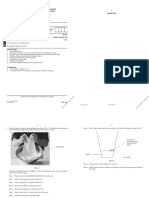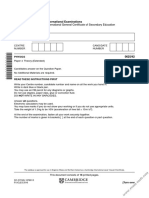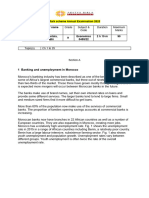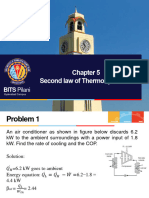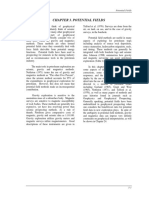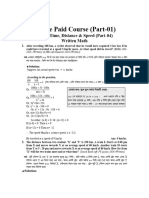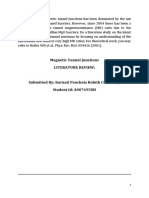Cambridge IGCSE: PHYSICS 0625/53
Cambridge IGCSE: PHYSICS 0625/53
Uploaded by
Ahaan DangiCopyright:
Available Formats
Cambridge IGCSE: PHYSICS 0625/53
Cambridge IGCSE: PHYSICS 0625/53
Uploaded by
Ahaan DangiOriginal Title
Copyright
Available Formats
Share this document
Did you find this document useful?
Is this content inappropriate?
Copyright:
Available Formats
Cambridge IGCSE: PHYSICS 0625/53
Cambridge IGCSE: PHYSICS 0625/53
Uploaded by
Ahaan DangiCopyright:
Available Formats
Cambridge IGCSE™
* 2 5 1 1 6 5 6 1 4 2 *
PHYSICS 0625/53
Paper 5 Practical Test October/November 2023
1 hour 15 minutes
You must answer on the question paper.
You will need: The materials and apparatus listed in the confidential instructions
INSTRUCTIONS
● Answer all questions.
● Use a black or dark blue pen. You may use an HB pencil for any diagrams or graphs.
● Write your name, centre number and candidate number in the boxes at the top of the page.
● Write your answer to each question in the space provided.
● Do not use an erasable pen or correction fluid.
● Do not write on any bar codes.
● You may use a calculator.
● You should show all your working and use appropriate units.
INFORMATION
● The total mark for this paper is 40.
● The number of marks for each question or part question is shown in brackets [ ].
For Examiner’s Use
Total
This document has 12 pages. Any blank pages are indicated.
m
co
e.
at
DC (KN/SW) 326733/2
-m
© UCLES 2023 [Turn over
am
x
.e
w
w
w
2
1 In this experiment, you will determine the density of sand by two methods.
Carry out the following instructions, referring to Fig. 1.1 and Fig. 1.2.
measuring
cylinder A
sand
top-pan
balance
bench bench
Fig. 1.1 Fig. 1.2
Method 1
(a) (i) Measure the mass m1 of measuring cylinder A using the top-pan balance, as shown in
Fig. 1.1.
m1 = ............................................................ g
Pour approximately 100 cm3 of sand into measuring cylinder A.
The sand is to remain in the measuring cylinder for the rest of the experiment.
Measure the volume V1 of sand in measuring cylinder A.
V1 = ........................................................ cm3
Measure the mass m2 of measuring cylinder A and the sand using the top-pan balance,
as shown in Fig. 1.2.
m2 = ............................................................ g
Use your values of m1 and m2 to calculate the mass m3 of the sand.
m3 = ............................................................ g
[2]
(ii) Calculate a value for the density ρ1 of the sand. Use your values from (a)(i) and the
m
equation ρ1 = 3. Include a unit.
V1
ρ1 = ......................................................... [2]
(iii) Describe one possible source of inaccuracy in the measurements taken in method 1. You
may assume that all measurements are taken carefully and involve good experimental
m
practice.
co
e.
at
...........................................................................................................................................
-m
am
..................................................................................................................................... [1]
x
© UCLES 2023 0625/53/O/N/23
.e
w
w
w
3
Method 2
measuring cylinder A
water
sand
Fig. 1.3
(b) (i) Pour exactly 100 cm3 of water into measuring cylinder B.
Pour this water into measuring cylinder A, as shown in Fig. 1.3.
Wait until the water level is constant then record the reading V2 of the water level in
measuring cylinder A.
V2 = .................................................. cm3 [1]
(ii) On Fig. 1.3, draw an arrow showing the correct line of sight for reading the water level in
measuring cylinder A. [1]
(iii) Calculate another value for the density ρ2 of the sand.
m3
Use your values from (a)(i) and (b)(i) and the equation ρ2 = , where k = 100 cm3.
(V2 - k)
ρ2 = ......................................................... [2]
(c) Another student wants to determine the density of the particles in a sample of sand.
(i) Explain why method 1 would not be a suitable method for her to use.
...........................................................................................................................................
..................................................................................................................................... [1]
(ii) Explain why method 2 would give a more accurate value for the density of the particles
in the sample of sand.
...........................................................................................................................................
m
co
..................................................................................................................................... [1]
e.
at
-m
[Total: 11]
am
[Turn over
x
© UCLES 2023 0625/53/O/N/23
.e
w
w
w
4
2 In this experiment, you will investigate the cooling of hot water in surroundings with different
temperatures.
Carry out the following instructions, referring to Fig. 2.1 and Fig. 2.2.
thermometer
lid
beaker A
beaker B
bench
Fig. 2.1
(a) (i) Pour 100 cm3 of cold water into beaker B.
Place the thermometer in the water.
Measure, and record in the appropriate column heading of Table 2.1, the temperature θ1
of the water. [1]
(ii) Remove the thermometer from the water in beaker B.
Remove the lid from beaker A.
Place beaker A inside beaker B, as shown in Fig. 2.2, so that the water in beaker B rises
between the sides of the two beakers.
beaker B
beaker A
water
Fig. 2.2
Pour 150 cm3 of hot water into beaker A and replace the lid.
Place the thermometer in the water in beaker A.
In Table 2.1, record the temperature θA of the water at time t = 0 and immediately start
the stop-watch.
Record the temperature θA of the water at t = 30 s, 60 s, 90 s, 120 s, 150 s and 180 s.
[1]
m
co
e.
at
-m
am
x
© UCLES 2023 0625/53/O/N/23
.e
w
w
w
5
(b) (i) Remove the thermometer and lid from beaker A.
Remove beaker A from beaker B and empty both beakers.
Pour 50 cm3 of cold water and 50 cm3 of hot water into beaker B.
Place the thermometer in the water.
Measure, and record in the appropriate column heading of Table 2.1, the temperature θ2
of the water.
[1]
(ii) Repeat (a)(ii) for this arrangement. [2]
Table 2.1
beaker A beaker A
in cold water in warm water
θ1 = ...................°C θ2 = ...................°C
t/s θA / °C θA / °C
0
30
60
90
120
150
180
(c) Write a conclusion stating in what way the temperature of the water surrounding beaker A
affects the rate of cooling of the hot water in beaker A.
Justify your answer by reference to values from your readings.
...................................................................................................................................................
...................................................................................................................................................
...................................................................................................................................................
............................................................................................................................................. [2]
m
co
e.
at
-m
am
[Turn over
x
© UCLES 2023 0625/53/O/N/23
.e
w
w
w
6
(d) Calculate the average cooling rate R for beaker A cooling in cold water. Use your readings for
beaker A from Table 2.1 and the equation
θA0 – θA180
R= T
where T = 180 s and θA0 and θA180 are the temperatures of the water in beaker A at t = 0 and
t = 180 s. Include the unit for the cooling rate.
R = ......................................................... [2]
(e) Another student repeats this experiment at the same room temperature.
State one other variable that she controls in order to obtain readings as close as possible to
your readings.
...................................................................................................................................................
............................................................................................................................................. [1]
(f) During the experiment, the increase in temperature of the water surrounding beaker A affects
the results of the investigation.
Suggest one change to the experiment to reduce this effect.
...................................................................................................................................................
...................................................................................................................................................
............................................................................................................................................. [1]
[Total: 11]
m
co
e.
at
-m
xam
© UCLES 2023 0625/53/O/N/23
.e
w
w
w
7
BLANK PAGE
m
co
e.
at
-m
am
[Turn over
x
© UCLES 2023 0625/53/O/N/23
.e
w
w
w
8
3 In this experiment, you will determine the focal length of a converging lens.
Carry out the following instructions, referring to Fig. 3.1.
illuminated u v screen
object
lens
lamp
bench
Fig. 3.1
(a) (i) Place the lens a distance u = 20.0 cm from the triangular illuminated object.
Place the screen near the lens.
Switch on the lamp.
Move the screen until a clear focused image of the triangular illuminated object is seen
on the screen.
Measure, and record in Table 3.1, the distance v between the lens and the screen.
Repeat the procedure for u = 30.0 cm, 40.0 cm, 50.0 cm and 60.0 cm.
Switch off the lamp.
Table 3.1
u
u / cm v / cm v
20.0
30.0
40.0
50.0
60.0
[2]
(ii) Describe a technique to obtain an image on the screen that is as sharp as possible in
this experiment.
...........................................................................................................................................
..................................................................................................................................... [1]
m
co
e.
at
-m
xam
© UCLES 2023 0625/53/O/N/23
.e
w
w
w
9
(b) For each distance u, calculate, and record in Table 3.1, a value for u. [1]
v
(c) Plot a graph of u / cm (y-axis) against u (x-axis). Start your graph at the origin (0,0).
v
Draw the best-fit line.
0
0
[4]
(d) (i) Determine the value u0 of u when u = 0.
v
u0 = ......................................................... [1]
(ii) The gradient of the graph is numerically equal to the focal length f of the lens.
Determine the value of f for this experiment.
Show clearly on the graph how you obtained the necessary information to determine the
gradient.
m
co
e.
f = ......................................................... [2]
at
-m
[Total: 11]
am
[Turn over
x
© UCLES 2023 0625/53/O/N/23
.e
w
w
w
10
4 A student investigates the brightness of a lamp.
Plan an experiment to investigate how the intensity (brightness) of the light produced by the lamp
is affected by the current in the lamp.
The apparatus available includes:
• a lamp and power supply
• a light meter which measures the intensity of light arriving at it
• an ammeter
• a variable resistor.
You are not required to do this experiment.
In your plan, you should:
• complete the circuit diagram in Fig. 4.1 to show the variable resistor connected to control the
current in the lamp
• state the key variables to be kept constant
• explain briefly how to do the experiment
• draw a table with column headings, to show how to display the readings (you are not required
to enter any readings in the table)
• explain how to use the readings to reach a conclusion.
light meter
Fig. 4.1
m
co
e.
at
-m
am
x
© UCLES 2023 0625/53/O/N/23
.e
w
w
w
11
..........................................................................................................................................................
..........................................................................................................................................................
..........................................................................................................................................................
..........................................................................................................................................................
..........................................................................................................................................................
..........................................................................................................................................................
..........................................................................................................................................................
..........................................................................................................................................................
..........................................................................................................................................................
..........................................................................................................................................................
..........................................................................................................................................................
..........................................................................................................................................................
..........................................................................................................................................................
..........................................................................................................................................................
..........................................................................................................................................................
..........................................................................................................................................................
..........................................................................................................................................................
..........................................................................................................................................................
..........................................................................................................................................................
.................................................................................................................................................... [7]
m
co
e.
at
-m
xam
© UCLES 2023 0625/53/O/N/23
.e
w
w
w
12
BLANK PAGE
Permission to reproduce items where third-party owned material protected by copyright is included has been sought and cleared where possible. Every
reasonable effort has been made by the publisher (UCLES) to trace copyright holders, but if any items requiring clearance have unwittingly been included, the
publisher will be pleased to make amends at the earliest possible opportunity.
m
To avoid the issue of disclosure of answer-related information to candidates, all copyright acknowledgements are reproduced online in the Cambridge
co
Assessment International Education Copyright Acknowledgements Booklet. This is produced for each series of examinations and is freely available to download
e.
at www.cambridgeinternational.org after the live examination series.
at
-m
Cambridge Assessment International Education is part of Cambridge Assessment. Cambridge Assessment is the brand name of the University of Cambridge
Local Examinations Syndicate (UCLES), which is a department of the University of Cambridge.
xam
© UCLES 2023 0625/53/O/N/23
.e
w
w
w
You might also like
- (Class 5th) Area and Perimeter 2Document6 pages(Class 5th) Area and Perimeter 2Snigdha Goel83% (6)
- HXN WSDocument11 pagesHXN WSminguijonjuanNo ratings yet
- Cambridge International AS & A Level: CHEMISTRY 9701/36Document12 pagesCambridge International AS & A Level: CHEMISTRY 9701/36yenhoang.nguyenNo ratings yet
- University of Cambridge International Examinations International General Certificate of Secondary EducationDocument16 pagesUniversity of Cambridge International Examinations International General Certificate of Secondary Educationnng.uyenchuoiNo ratings yet
- Cambridge IGCSE: CHEMISTRY 0620/61Document12 pagesCambridge IGCSE: CHEMISTRY 0620/61jiana shroffNo ratings yet
- 970912_Spring_2024Document16 pages970912_Spring_2024Nekk BắpNo ratings yet
- University of Cambridge International Examinations General Certificate of Education Ordinary LevelDocument20 pagesUniversity of Cambridge International Examinations General Certificate of Education Ordinary LevelHuma RaoNo ratings yet
- 0625_s11_qp_61_with_drawingDocument12 pages0625_s11_qp_61_with_drawingDr Sumaira AmbreenNo ratings yet
- Cambridge IGCSE: Computer Science 0478/11Document12 pagesCambridge IGCSE: Computer Science 0478/11nathanmotha1No ratings yet
- 9702 w13 QP 21Document16 pages9702 w13 QP 21AriaNathanNo ratings yet
- University of Cambridge International Examinations International General Certificate of Secondary EducationDocument12 pagesUniversity of Cambridge International Examinations International General Certificate of Secondary Education정상진No ratings yet
- 9702 s21 QP 35 MergedDocument68 pages9702 s21 QP 35 MergedXNo ratings yet
- University of Cambridge International Examinations General Certificate of Education Advanced Subsidiary Level and Advanced LevelDocument16 pagesUniversity of Cambridge International Examinations General Certificate of Education Advanced Subsidiary Level and Advanced LevelManasseh GunzoNo ratings yet
- Cambridge IGCSE: Computer Science 0478/22Document16 pagesCambridge IGCSE: Computer Science 0478/22The Engineer GuyNo ratings yet
- University of Cambridge International Examinations International General Certificate of Secondary EducationDocument16 pagesUniversity of Cambridge International Examinations International General Certificate of Secondary EducationmariamenendezledesmaNo ratings yet
- 0450 s11 QP 11Document12 pages0450 s11 QP 11Fuzail NaseerNo ratings yet
- University of Cambridge International Examinations International General Certificate of Secondary EducationDocument20 pagesUniversity of Cambridge International Examinations International General Certificate of Secondary EducationHồng Ngọc VõNo ratings yet
- Biology 5090Document8 pagesBiology 5090GB HackerNo ratings yet
- Cambridge IGCSE: Mathematics 0580/43Document24 pagesCambridge IGCSE: Mathematics 0580/43asunachen0No ratings yet
- 4024 w13 QP 11 PDFDocument20 pages4024 w13 QP 11 PDFChristine SetiawanNo ratings yet
- Cambridge International General Certificate of Secondary EducationDocument12 pagesCambridge International General Certificate of Secondary EducationMahadi HasanNo ratings yet
- University of Cambridge International Examinations General Certificate of Education Ordinary LevelDocument20 pagesUniversity of Cambridge International Examinations General Certificate of Education Ordinary Levelbaraa waelNo ratings yet
- Cambridge IGCSE: Computer Science 0478/12Document12 pagesCambridge IGCSE: Computer Science 0478/12jamessebastian782No ratings yet
- Cambridge IGCSE: MATHEMATICS 0580/22Document12 pagesCambridge IGCSE: MATHEMATICS 0580/22girijasNo ratings yet
- Cambridge International Advanced Subsidiary and Advanced LevelDocument12 pagesCambridge International Advanced Subsidiary and Advanced LevelLabiba GulNo ratings yet
- Biology 23 Paper 6Document44 pagesBiology 23 Paper 6MattMattTv JapanNo ratings yet
- Cambridge International A Level: HINDI 9687/05Document4 pagesCambridge International A Level: HINDI 9687/05agastya bhardwajNo ratings yet
- Cambridge IGCSEDocument8 pagesCambridge IGCSEyennymath0No ratings yet
- University of Cambridge International Examinations General Certificate of Education Ordinary LevelDocument16 pagesUniversity of Cambridge International Examinations General Certificate of Education Ordinary LevelDinesh Samantha DissanayakeNo ratings yet
- University of Cambridge International Examinations General Certificate of Education Advanced LevelDocument8 pagesUniversity of Cambridge International Examinations General Certificate of Education Advanced LevelMystic Blade7No ratings yet
- Cambridge International General Certificate of Secondary EducationDocument16 pagesCambridge International General Certificate of Secondary Educationranim ismailNo ratings yet
- Chemistry 0620 - s11 - QP - 31Document12 pagesChemistry 0620 - s11 - QP - 31mohammadNo ratings yet
- 4024_s24_qp_12Document20 pages4024_s24_qp_12CCSC124-Soham MaityNo ratings yet
- University of Cambridge International Examinations International General Certificate of Secondary EducationDocument28 pagesUniversity of Cambridge International Examinations International General Certificate of Secondary EducationWayne WeiNo ratings yet
- University of Cambridge International Examinations International General Certificate of Secondary EducationDocument16 pagesUniversity of Cambridge International Examinations International General Certificate of Secondary EducationSidumo DlaloseNo ratings yet
- Cambridge IGCSE: Chemistry 0620/62Document12 pagesCambridge IGCSE: Chemistry 0620/62Rishabh RaoNo ratings yet
- IGCSE Hindi PaperDocument12 pagesIGCSE Hindi PaperAndrew Chettiar0% (1)
- 0625 - s22 - QP - 4 (Extended) 1 PDFDocument16 pages0625 - s22 - QP - 4 (Extended) 1 PDFJoey DingNo ratings yet
- Cambridge IGCSEDocument16 pagesCambridge IGCSEatreyi.2782No ratings yet
- Cambridge International AS & A Level: Mathematics 9709/53Document16 pagesCambridge International AS & A Level: Mathematics 9709/53asunachen0No ratings yet
- University of Cambridge International Examinations International General Certificate of Secondary EducationDocument24 pagesUniversity of Cambridge International Examinations International General Certificate of Secondary EducationWayne WeiNo ratings yet
- University of Cambridge International Examinations International General Certificate of Secondary EducationDocument16 pagesUniversity of Cambridge International Examinations International General Certificate of Secondary Educationcyl97342217No ratings yet
- 0625 s06 QP 6Document12 pages0625 s06 QP 6lylanNo ratings yet
- University of Cambridge International Examinations International General Certificate of Secondary EducationDocument16 pagesUniversity of Cambridge International Examinations International General Certificate of Secondary EducationashwinplayzbrawlstarsNo ratings yet
- University of Cambridge International Examinations International General Certificate of Secondary EducationDocument28 pagesUniversity of Cambridge International Examinations International General Certificate of Secondary EducationWayne WeiNo ratings yet
- 0625 s09 QP 2Document20 pages0625 s09 QP 2lylanNo ratings yet
- University of Cambridge International Examinations General Certificate of Education Advanced LevelDocument28 pagesUniversity of Cambridge International Examinations General Certificate of Education Advanced Leveltruejoymagaya99No ratings yet
- University of Cambridge International Examinations International General Certificate of Secondary EducationDocument24 pagesUniversity of Cambridge International Examinations International General Certificate of Secondary EducationWayne WeiNo ratings yet
- University of Cambridge International Examinations International General Certificate of Secondary EducationDocument20 pagesUniversity of Cambridge International Examinations International General Certificate of Secondary EducationHikmaNo ratings yet
- University of Cambridge International Examinations International General Certificate of Secondary EducationDocument16 pagesUniversity of Cambridge International Examinations International General Certificate of Secondary Educationxelowa2256No ratings yet
- University of Cambridge International Examinations International General Certificate of Secondary EducationDocument16 pagesUniversity of Cambridge International Examinations International General Certificate of Secondary EducationYuichi AkasakaNo ratings yet
- University of Cambridge International Examinations: General Certificate of Education Ordinary LevelDocument24 pagesUniversity of Cambridge International Examinations: General Certificate of Education Ordinary LevelAbdul moiz WaheedNo ratings yet
- University of Cambridge International Examinations International General Certificate of Secondary EducationDocument28 pagesUniversity of Cambridge International Examinations International General Certificate of Secondary EducationWayne WeiNo ratings yet
- 9702_s10_qp_35Document12 pages9702_s10_qp_35ahsantech33No ratings yet
- University of Cambridge International Examinations International General Certificate of Secondary EducationDocument16 pagesUniversity of Cambridge International Examinations International General Certificate of Secondary EducationVania AroraNo ratings yet
- Physics: PAPER 5 Practical Test Answer BookletDocument8 pagesPhysics: PAPER 5 Practical Test Answer BookletTr AstellaNo ratings yet
- 0610 s19 QP 51Document16 pages0610 s19 QP 51Humaid SultanNo ratings yet
- University of Cambridge International Examinations International General Certificate of Secondary EducationDocument16 pagesUniversity of Cambridge International Examinations International General Certificate of Secondary EducationChong Xue ErNo ratings yet
- Eurasian Cities: New Realities along the Silk RoadFrom EverandEurasian Cities: New Realities along the Silk RoadRating: 3.5 out of 5 stars3.5/5 (1)
- It's So Easy Going Green: An Interactive, Scientific Look at Protecting Our EnvironmentFrom EverandIt's So Easy Going Green: An Interactive, Scientific Look at Protecting Our EnvironmentNo ratings yet
- 9th Grade - Seating Plan - 15 May 2024.Document10 pages9th Grade - Seating Plan - 15 May 2024.Ahaan DangiNo ratings yet
- INMO Race - 5Document2 pagesINMO Race - 5Ahaan DangiNo ratings yet
- INMO Race - 6-2Document2 pagesINMO Race - 6-2Ahaan DangiNo ratings yet
- Geometry PC 221213 123627Document6 pagesGeometry PC 221213 123627Ahaan DangiNo ratings yet
- For Students Grade 9 Economics Paper22 MS Annual ExaminationDocument7 pagesFor Students Grade 9 Economics Paper22 MS Annual ExaminationAhaan Dangi100% (1)
- Assignment # 6 - SolutionsDocument3 pagesAssignment # 6 - SolutionsAhaan DangiNo ratings yet
- Tutorial Problems-Ch 5Document36 pagesTutorial Problems-Ch 5nonstopforever9266No ratings yet
- Theory Physics For KVLDocument19 pagesTheory Physics For KVLworth lessNo ratings yet
- Mod3 Perform Mensuration Calculation - 1Document40 pagesMod3 Perform Mensuration Calculation - 1DaneNo ratings yet
- Atv12 Drive Atv12h075m2Document10 pagesAtv12 Drive Atv12h075m2Muhammad KhairuddinNo ratings yet
- Potential Fields2Document11 pagesPotential Fields2Nehal patelNo ratings yet
- Chapter 2 Linear MotionDocument33 pagesChapter 2 Linear MotionJerome FizzowNo ratings yet
- HFRR KoehlerDocument2 pagesHFRR KoehlertswNo ratings yet
- Ship Resistance Project Holtrop and MennenDocument9 pagesShip Resistance Project Holtrop and MennenSara AliNo ratings yet
- Class XI-Physics CDF BookDocument25 pagesClass XI-Physics CDF BooknagathikshaaNo ratings yet
- Subtle WeighDocument28 pagesSubtle WeighRaj K SharmaNo ratings yet
- UV VIS Spectroscopy and SpectrophotometryDocument18 pagesUV VIS Spectroscopy and Spectrophotometrymajdkhashan999No ratings yet
- Time Speed Part-4Document12 pagesTime Speed Part-4galib.papatigerNo ratings yet
- AUSPOS GPS Processing Report: September 5, 2022Document7 pagesAUSPOS GPS Processing Report: September 5, 2022Yohana YonasNo ratings yet
- Chapter 14 Kinetics of Particle - Work EnergyDocument37 pagesChapter 14 Kinetics of Particle - Work EnergyISLAMIC VOICENo ratings yet
- A0076958H - Karnati Penchal Rohith Chowdary EE5202 ProjectDocument21 pagesA0076958H - Karnati Penchal Rohith Chowdary EE5202 Projectrohithchowdary15No ratings yet
- HL7 Reference Information ModelDocument30 pagesHL7 Reference Information ModelAgus MutamakinNo ratings yet
- Height and Weight Conversion ChartDocument4 pagesHeight and Weight Conversion Chartjustrajinder1234No ratings yet
- Chapter 12 PDFDocument2 pagesChapter 12 PDFKaren MartinNo ratings yet
- Bro Ufp 20Document2 pagesBro Ufp 20Aimee chaconNo ratings yet
- Viscosity Experiment+Audio RecordingDocument15 pagesViscosity Experiment+Audio RecordingFayNo ratings yet
- CABINA Calibracion Setup & Alarm Testing Method StatementDocument16 pagesCABINA Calibracion Setup & Alarm Testing Method StatementJ VkNo ratings yet
- Power Capacitors: MH Vishay ESTADocument63 pagesPower Capacitors: MH Vishay ESTApookeNo ratings yet
- ExamView - Circles Quiz 1 ReviewDocument9 pagesExamView - Circles Quiz 1 ReviewSlowed and ReverbedNo ratings yet
- AQA A Level Physics: 77 MinutesDocument25 pagesAQA A Level Physics: 77 MinutesalbinjensNo ratings yet
- Modbus RegisterDocument7 pagesModbus RegisterZuniiga AndersonNo ratings yet
- Grand Test-1 PhysicsDocument6 pagesGrand Test-1 Physicsnavothithajeyaram123No ratings yet
- 14Φ Series Metal Oxide Varistor (MOV) Data Sheet: FeaturesDocument12 pages14Φ Series Metal Oxide Varistor (MOV) Data Sheet: Featuresirensy vivasNo ratings yet
- PhysicsDocument6 pagesPhysicsmahamushtaha0No ratings yet

























